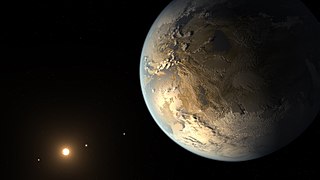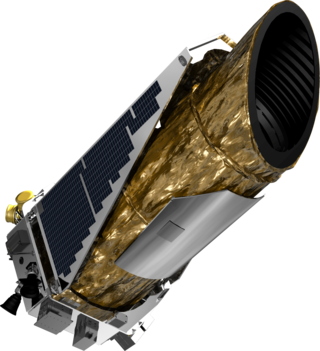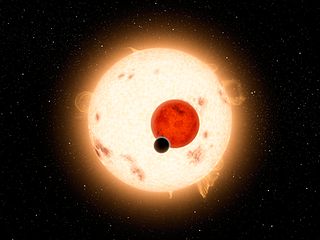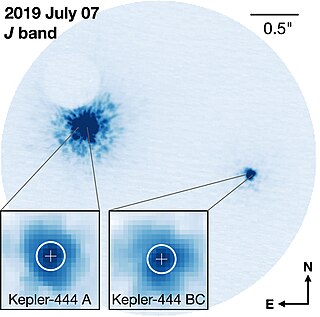
These are lists of planets. A planet is a large, rounded astronomical body that is neither a star nor its remnant. The best available theory of planet formation is the nebular hypothesis, which posits that an interstellar cloud collapses out of a nebula to create a young protostar orbited by a protoplanetary disk. There are eight planets within the Solar System; planets outside of the solar system are also known as exoplanets.

Michel Gustave Édouard Mayor is a Swiss astrophysicist and professor emeritus at the University of Geneva's Department of Astronomy. He formally retired in 2007, but remains active as a researcher at the Observatory of Geneva. He is co-laureate of the 2019 Nobel Prize in Physics along with Jim Peebles and Didier Queloz, and the winner of the 2010 Viktor Ambartsumian International Prize and the 2015 Kyoto Prize.

The Kepler space telescope is a defunct space telescope launched by NASA in 2009 to discover Earth-sized planets orbiting other stars. Named after astronomer Johannes Kepler, the spacecraft was launched into an Earth-trailing heliocentric orbit. The principal investigator was William J. Borucki. After nine and a half years of operation, the telescope's reaction control system fuel was depleted, and NASA announced its retirement on October 30, 2018.

Geoffrey William Marcy is an American astronomer. He was an early influence in the field of exoplanet detection, discovery, and characterization. Marcy was a professor of astronomy at the University of California, Berkeley, and an adjunct professor of physics and astronomy at San Francisco State University. Marcy and his research teams discovered many extrasolar planets, including 70 out of the first 100 known exoplanets and also the first planetary system around a Sun-like star, Upsilon Andromedae. Marcy was a co-investigator on the NASA Kepler mission. His collaborators have included R. Paul Butler, Debra Fischer and Steven S. Vogt, Jason Wright, Andrew Howard, Katie Peek, John Johnson, Erik Petigura, Lauren Weiss, Lea Hirsch and the Kepler Science Team. Following an investigation for sexual harassment in 2015, Marcy resigned his position at the University of California, Berkeley.

TrES-2b (Kepler-1b) is an extrasolar planet orbiting the star GSC 03549-02811 located 750 light years away from the Solar System. The planet was identified in 2011 as the darkest known exoplanet, reflecting less than 1% of any light that hits it. Reflecting less light than charcoal, on the surface the planet is said to be pitch black. The planet's mass and radius indicate that it is a gas giant with a bulk composition similar to that of Jupiter. Unlike Jupiter, but similar to many planets detected around other stars, TrES-2b is located very close to its star and belongs to the class of planets known as hot Jupiters. This system was within the field of view of the Kepler spacecraft.

Transiting Exoplanet Survey Satellite is a space telescope for NASA's Explorer program, designed to search for exoplanets using the transit method in an area 400 times larger than that covered by the Kepler mission. It was launched on 18 April 2018, atop a Falcon 9 launch vehicle and was placed into a highly elliptical 13.70-day orbit around the Earth. The first light image from TESS was taken on 7 August 2018, and released publicly on 17 September 2018.

An exoplanet is a planet located outside the Solar System. The first evidence of an exoplanet was noted as early as 1917, but was not recognized as such until 2016; no planet discovery has yet come from that evidence. What turned out to be the first detection of an exoplanet was published among a list of possible candidates in 1988, though not confirmed until 2003. The first confirmed detection came in 1992, with the discovery of terrestrial-mass planets orbiting the pulsar PSR B1257+12. The first confirmation of an exoplanet orbiting a main-sequence star was made in 1995, when a giant planet was found in a four-day orbit around the nearby star 51 Pegasi. Some exoplanets have been imaged directly by telescopes, but the vast majority have been detected through indirect methods, such as the transit method and the radial-velocity method. As of 1 April 2024, there are 5,653 confirmed exoplanets in 4,161 planetary systems, with 896 systems having more than one planet. This is a list of the most notable discoveries.

Kepler-16b is an exoplanet. It is a Saturn-mass planet consisting of half gas and half rock and ice, and it orbits a binary star, Kepler-16, with a period of 229 days. "[It] is the first confirmed, unambiguous example of a circumbinary planet – a planet orbiting not one, but two stars," said Josh Carter of the Center for Astrophysics | Harvard & Smithsonian, one of the discovery team.

Kepler-42, formerly known as KOI-961, is a red dwarf located in the constellation Cygnus and approximately 131 light years from the Sun. It has three known extrasolar planets, all of which are smaller than Earth in radius, and likely also in mass.

Lisa Kaltenegger is an Austrian world-leading astronomer with expertise in the modeling and characterization of exoplanets and the search for life. On July 1, 2014, she was appointed Associate Professor of Astronomy at Cornell University. Previously, she held a joint position at the Max Planck Institute for Astronomy in Heidelberg where she was the Emmy Noether Research Group Leader for the "Super-Earths and Life" group, and at the Center for Astrophysics | Harvard & Smithsonian in Cambridge, MA. She was appointed Lecturer in 2008 at Harvard University and 2011 at University of Heidelberg.

Kepler-62f is a super-Earth exoplanet orbiting within the habitable zone of the star Kepler-62, the outermost of five such planets discovered around the star by NASA's Kepler spacecraft. It is located about 980 light-years from Earth in the constellation of Lyra.

A sub-Earth is a planet "substantially less massive" than Earth and Venus. In the Solar System, this category includes Mercury and Mars. Sub-Earth exoplanets are among the most difficult type to detect because their small sizes and masses produce the weakest signal. Despite the difficulty, one of the first exoplanets found was a sub-Earth around a millisecond pulsar PSR B1257+12. The smallest known is WD 1145+017 b with a size of 0.15 Earth radii, or somewhat smaller than Pluto. However, WD 1145+017 b is not massive enough to qualify as a sub-Earth classical planet and is instead defined as a minor, or dwarf, planet. It is orbiting within a thick cloud of dust and gas as chunks of itself continually break off to then spiral in towards the star, and within around 5,000 years it will have more-or-less disintegrated.

Kepler-90, also designated 2MASS J18574403+4918185, is a F-type star located about 2,790 light-years (855 pc) from Earth in the constellation of Draco. It is notable for possessing a planetary system that has the same number of observed planets as the Solar System.

Kepler-444 is a triple star system, estimated to be 11.2 billion years old, approximately 119 light-years (36 pc) away from Earth in the constellation Lyra. On 27 January 2015, the Kepler spacecraft is reported to have confirmed the detection of five sub-Earth-sized rocky exoplanets orbiting the main star. The star is a K-type main sequence star. All of the planets are far too close to their star to harbour life forms.

The Nexus for Exoplanet System Science (NExSS) initiative is a National Aeronautics and Space Administration (NASA) virtual institute designed to foster interdisciplinary collaboration in the search for life on exoplanets. Led by the Ames Research Center, the NASA Exoplanet Science Institute, and the Goddard Institute for Space Studies, NExSS will help organize the search for life on exoplanets from participating research teams and acquire new knowledge about exoplanets and extrasolar planetary systems.

Stephen Kane is a full professor of astronomy and planetary astrophysics at the University of California, Riverside who specializes in exoplanetary science. His work covers a broad range of exoplanet detection methods, including the microlensing, transit, radial velocity, and imaging techniques. He is a leading expert on the topic of planetary habitability and the habitable zone of planetary systems. He has published hundreds of peer reviewed scientific papers and has discovered/co-discovered several hundred planets orbiting other stars. He is a prolific advocate of interdisciplinarity science and studying Venus as an exoplanet analog.
Kepler-1229 is a red dwarf star located about 870 light-years (270 pc) away from the Earth in the constellation of Cygnus. It is known to host a super-Earth exoplanet within its habitable zone, Kepler-1229b, which was discovered in 2016.

Jessie Christiansen is an Australian astrophysicist working at the NASA Exoplanet Science Institute at the California Institute of Technology (Caltech). She won the 2018 NASA Exceptional Engineering Achievement Medal for her work on the Kepler planet sample.

















